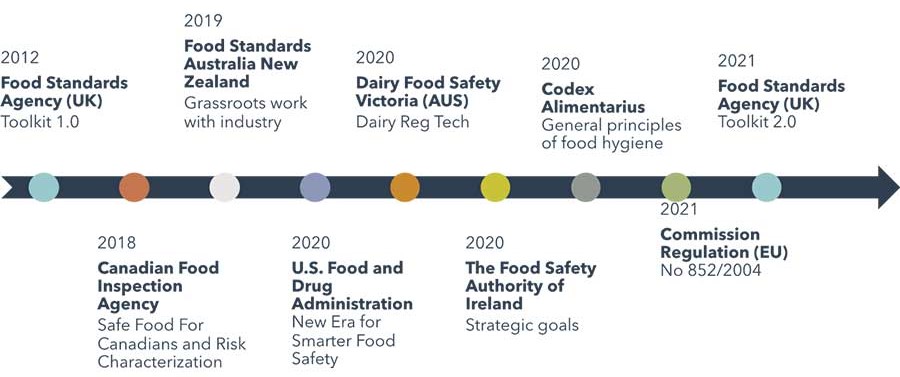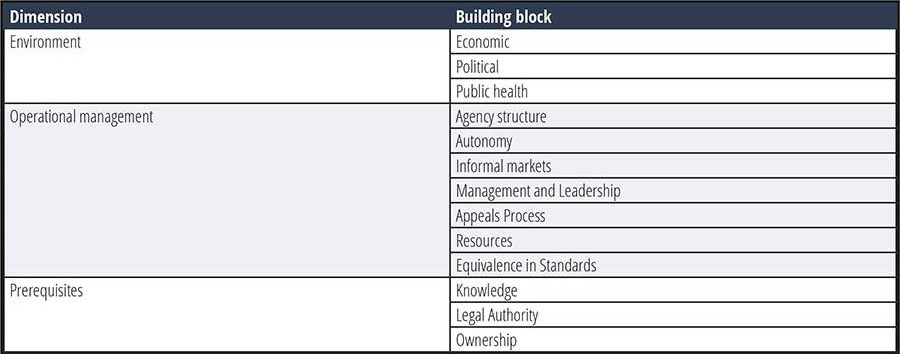Food Safety Culture Collaboration: Are Regulators Adapting and Catching Up?

Video credit: piola666/Creatas Video via Getty Images
The current landscape of food systems is characterized by intricate global networks, and ensuring food safety means managing risks throughout the entire supply chain. In today's context, stakeholders encompass all those engaged in the interlinked activities of cultivation, gathering, processing, packaging, transportation, storage, and the final sale of the food product. Importantly, a single stakeholder can assume different roles within the supply chain. Furthermore, it is highly probable that ingredients or raw materials originate from international sources. Within every phase of the journey from production to consumption, food must be evaluated for potential hazards.
Food companies sometimes encounter challenges to documenting their complete supply chains. Nevertheless, documenting the complexity of this supply chain is imperative for complying with federal and international food safety regulations, minimizing risks, and meeting consumers' food safety and transparency expectations in the supply chain.
The reduction of food safety risk hinges on fostering collaboration among food enterprises, authorities, and consumers, with all taking responsibility for shared solutions. Food companies, as key stakeholders in the food supply chain, must actively engage in sharing information, best practices, and innovations to collectively ensure the highest standards of food safety. Regulatory authorities play a pivotal role in establishing and enforcing stringent guidelines and objective regulations, while also facilitating transparent communication with businesses. Equally important, consumers' awareness and expectations for safe food practices bolster the effectiveness of the system.
The need to prevent injuries, illnesses, and fatalities is a common goal among regulators and industry globally. While regulations are designed by legislators, the implementation, enforcement, and communication of the regulations is performed by food safety regulatory and enforcement agencies (FSRAs) across the world. The objectives of FSRAs include activities such as making scientific judgements founded on risk evaluation, advocating and formulating strategies for risk assessment, initiating scientific research projects, evaluating scientific information, pinpointing emerging hazards, and openly sharing information about imminent risks with other countries.
Enterprises, authorities, and consumers form the structure that holds the food safety system together. By openly sharing information about near-misses and failures, food businesses not only learn from their own experiences but also contribute to the collective insights, preventing others from making the same mistakes. Trust acts as a catalyst, encouraging companies to step forward and share their difficulties without fear of punitive actions. This shared learning approach can be a proactive tool for addressing vulnerabilities, closing gaps in food safety protocols, and enhancing overall risk management.
However, trust does not develop in isolation; it thrives in an environment of cooperation and understanding. FSRAs play a vital role in nurturing this environment by offering a non-punitive stance toward errors and emphasizing the importance of continuous improvement while providing guidance to various stakeholders. When authorities collaborate with industry, they create a space where discussions about failures and challenges are seen as opportunities for growth.
Consumers are integral participants in this trust-building process. An informed and engaged consumer base contributes to a demand for supply chain transparency and accountability. When consumers are confident that companies and regulatory bodies are working together to tackle food safety issues, trust in the food supply chain is strengthened.
Looking for quick answers on food safety topics?
Try Ask FSM, our new smart AI search tool.
Ask FSM →
A Decade of FSRA Food Safety Culture Learnings
For a long time, industry has been held accountable to food safety auditing schemes aligned with GFSI benchmarking requirements, such as SQFI, IFS, FSSC, GRMS, and BRC. As such, since 2020, food safety culture as an audit requirement has incorporated an evaluation of a company's food safety culture. As a result, these businesses are expected to consistently enhance their food safety protocols and operational efficiencies by improving their organizational culture. Interestingly, the drivers for these transformations have been to meet customer requirements, not to meet requirements from regulatory bodies.
FSRAs are following industry in a pursuit to improve their own food safety culture. If they fail at this, then the collaboration, transparency, and trust between FSRAs, industry, and consumers can be damaged or difficult to establish. Thus, several countries, organizations, and companies have taken proactive measures to enhance their food safety cultures. Since 2021, many FSRAs globally have incorporated the concept of organizational culture into their food safety audits (Figure 1). Entities from the UK, Canada, Australia and New Zealand, the U.S., and Ireland [UK Food Standards Agency (FSA), Food Safety Authority of Ireland (FSAI), Canadian Food Inspection Agency (CFIA), Food Standards Australia New Zealand (FSANZ), Dairy Food Safety Victoria (DFSV), and U.S. Food and Drug Administration (FDA)] have been trailblazers since 2012. In addition, many nations have contributed to the Codex revision of the General Principles of Food Hygiene.1

In its 2018 seminal work, the Global Food Safety Initiative (GFSI) published its framework for food safety culture, which consists of five dimensions: Vision and Mission, People, Consistency, Adaptability, and Hazards and Risk Awareness.2
In 2012, the UK's FSA was the first regulator to publish a food safety culture framework,3 which focuses on six cultural dimensions. The next model to be published was the DFSV's Food Safety Culture Model, in 2020.4 The DFSV model uses the same dimensions as the GFSI framework. Codex revised the General Principles of Food Hygiene in 20201 to include food safety culture conditions. The EU built its 2021 food safety requirements on Codex, and is the first and only FSRA to date to regulate food safety culture.5
FSRA Food Safety Culture Models External to Agency
The good news is that there are similarities among the FSRA food safety culture frameworks (Table 1). Also, each framework owner can learn from the others to collectively make future work stronger and more meaningful. While there are three scientific and/or experiential foundations for these frameworks (i.e., GFSI, FSA, and Codex), they all share a common purpose to further integrate social science theories and practices in the improvement of food safety performance. As can be deduced from Table 1, dimensions might be named differently, and the scope may vary for each dimension, but all are focused on enabling people in the global food industry to cultivate a mindset and practices of food safety in the context of their organization's culture.
Food safety culture development is inherently about developing people. A mature food safety culture is connected to the ongoing improvement of an organization's culture. To gather experience of such development processes and be able to share and develop culture, a study was performed by the Danish Agriculture and Food Council (DAFC),6 where voluntary employees engaged in therapeutic training of their human competencies (sensory and emotional skills). The therapeutic training focused on increasing awareness of their own culture and practices to change it (committing oneself to take leadership of one's own culture), with the focus of increasing experience sharing. Volunteer employees were trained to continuously become sensory present and allow emotions to become aware of the root causes of their "wants to action" and "ideas/thoughts," enabling them to address unconscious underlying mechanisms and communicate openly and honestly, as opposed to acting and reacting automatically. The development of culture change agents is foundational for driving food safety culture development processes.
Dimension 1: Commitment Materialized in Vision, Mission, Priorities, and Attitude
One regulatory food safety culture dimension is about vision, mission, priorities, and attitude. These elements are often referred to as the commitment of the management and all employees to the safe production and distribution of food. In these terms, commitment is materialized through the company's vision for the business and for food safety. This, in turn, informs the mission of the company and helps with setting priorities. The attitude of the individuals in a food company also fits in this dimension. Attitude is influenced by the collective ability of everyone in the food company. The ability to take responsibility in practice is dependent on one's own self-awareness of and willingness to address one's own behaviors.
Dimension 2: Perception, Insights, Courage, and Leadership
Another regulatory food safety dimension is related to leadership. Seen through the different frameworks in Table 1, this includes perception and knowledge of leaders, as well as confidence in the production of safe food and engaging all employees in food safety practices. It is about detailing what it is that leaders perceive as important to their business and how food safety fits into this. Leadership is about taking responsibility and having the confidence to own culture, and thereby become able to change the surrounding culture. It is about everyone becoming aware of food safety needs, and being able to change and develop the culture and practice food safety. It includes integrity, meaning conformity between actions and words, and "walking the talk." Leadership is about putting action into practice and leading by example for other employees to do the same.
Dimension 3: Hazard and Risk Awareness
A third regulatory food safety dimension is awareness of food safety hazards and of the importance of food safety and hygiene by all employees in the business. This includes adherence to the food safety system. This cultural dimension focuses on ensuring awareness across a food business of its hazards and risks. Awareness, in turn, influences priorities and investments in the food safety system and the company culture. This dimension largely sets the food safety culture frameworks in Table 1 apart from that of a generic organizational culture framework. The efforts that leaders put into their own understanding of food safety hazards, risks, and root causes are directly related to the perceptions of their colleagues of the importance of food safety for their organizations. Risks must be defined using food science and social science principles to include all hazards that can lead to a breach of food safety (e.g., biological and psycho-social hazards).
Dimension 4: Messaging, Engagement, Trust, and Communications
Another regulatory food safety dimension is related to messaging as a form of building trust and engaging everyone in a food company in food safety. Open and clear communication must occur between all employees in the business, and must include communication of deviations and expectations. Messaging, engagement, and communication can be challenging; therefore, it can be beneficial to include alternative methods of communication (e.g., drawings or graphs). It is important to use translations to employees' native languages. Transparency in communication is crucial, including when sharing deviations and expectations. Also, honesty, sincerity, and authenticity are needed to build trust, as it is crucial that mistakes, failures, and near-misses are shared. Psychological safety is needed, and psycho-social hazards must be assessed as part of the stakeholder analysis and experience sharing to ensure trust and engagement.
Dimension 5: Consistency and Resourcing
A fifth regulatory food safety culture dimension around consistency and resourcing speaks to the importance of infrastructure (e.g., data systems, documents, and the people needed to make safe foods). It is an interesting dimension when looking at private vs. public frameworks, since resourcing is often seen as an outcome of culture and not a dimension on its own. This dimension includes the availability of sufficient resources to ensure the safe handling of food. For example, it is important to assess if resources are available for training and communication and to organize sufficient and relevant training for all levels of the organization.
Proposed Model for FSRA Internal Food Safety Culture
According to the framework outlined in the Principles and Guidelines for National Food Control Systems9 by the Codex Alimentarius Commission in 2013, individual countries retain the authority to shape their food control systems and to enact specific regulatory measures if they can guarantee the health and welfare of the public. Regardless of the structure of these national frameworks, the assessment of effectiveness, the ability to make ongoing improvements, and the optimization of processes and functions stand as crucial for all FSRAs. This endeavor not only enhances the quality of the services rendered but also accomplishes the following: (1) cultivates confidence among stakeholders, (2) reinforces the global reputation of the national food system, and (3) unlocks avenues to new international markets through favorable trade agreements.
Examining the actions of food safety regulatory bodies in different nations proves to be highly valuable. While country-specific regulations, systems, methods, procedures, and documentation may be influenced by different laws and guidelines, shared principles and approaches can also be successfully adapted across borders. Therefore, gleaning insights from the practices of other regulatory entities offers a pathway to evaluate and enhance one's own systems. Food safety culture improvement applies to all stakeholders of the global complex food system, which includes the regulatory bodies themselves.
Establishing a strategy to enhance food safety culture within a regulatory organization can yield considerable influence in improving food safety culture in companies. This approach serves a dual purpose: firstly, regulators can align their actions with their recommendations, setting an example through practice; and secondly, this equips regulators with heightened awareness and expertise in evaluating practices, systems, and procedures applicable to food manufacturers.
While autonomy within public-sector organizations at the national level is a vital aspect in advancing efficient and resilient national governance mechanisms, there is a need to provide support to such entities in evaluating the effectiveness and maturity of the national food safety auditing and inspection systems. Crafting an assessment system that holds global applicability would offer substantial assistance to all pertinent organizations, enabling them to gauge performance and maturity against standardized benchmarks.
The FSRA maturity model in Nayak and Jespersen10 presents globally applicable building blocks designed to assess and benchmark the effectiveness, ability to achieve continuous improvement, and optimize the processes and functioning of food safety regulatory and enforcement agencies across the world (Table 2). The foundation of the model is established through two main elements. The first is a comprehensive analysis of worldwide safety regulations to chart the extent and the functions carried out by the relevant FSRAs. The second element encompasses insights gathered from expert stakeholders who offer perspectives on the roles of FSRAs and identify gaps in existing service assessment strategies deployed by FSRAs globally. Current research in the domain of food safety regulations and management systems has often centered on examining the significance and implementation of these regulations and systems. Additionally, studies have delved into evaluating aspects such as culture, climate, and behavioral shifts within private food-related entities, while also assessing their influence on market dynamics and pricing.

The FSRA maturity model identifies how regulators can improve their operations by using a self-assessment tool, a notion endorsed by food safety regulators.
The maturity model must consider the diverse practices adopted by various FSRAs, shedding light on the challenges they encounter and the strategies they implement to mitigate the impact on public health and trade. The maturity model must also offer insights into adeptly managing conflicting priorities, such as trade and public health, within the FRSA domain. As this tool is intended for use by national FSRAs, it is imperative that future research involve collaborative efforts with these agencies to gauge the framework's applicability in practice. A collaborative approach with global food safety regulatory agencies and industry is required to contribute to the development of a maturity scale, enabling agencies to self-evaluate their maturity levels and identify areas requiring improvement.
The progression of the maturity model for FSRAs necessitates a concerted effort to inspire collaborative engagement among diverse regulatory bodies from across the globe. Steps should revolve around developing a universally applicable maturity scale, stacking upon the foundational building blocks previously identified in the Nayak and Jespersen study.10 The urgency of this initiative stems from its potential to enhance the efficiency, effectiveness, and culture within FSRAs. The collaborative approach is essential not only to ensure consistent practices, but also to harness the collective expertise and perspectives of FSRAs and industry.
To embark on this endeavor, the first step should involve assembling a multidisciplinary team of experts from regulatory agencies and industry worldwide. These experts should hail from diverse backgrounds, encompassing regulatory frameworks, public health, trade, technology, and organizational culture leadership. Such a diverse team can provide a thorough exploration and well-rounded perspective, ensuring that the maturity model addresses the intricate interplay of factors influencing FSRA operations.
The second step entails a comprehensive review and refinement of the existing building blocks. This iterative process should integrate feedback from participating regulatory agencies and industry and consider variations in environments, cultural nuances, and resource constraints. The goal is to distill a universally relevant maturity model that encapsulates the core attributes of a mature FSRA.
Following this, collaborative workshops, forums, and working groups should be organized to facilitate open dialogue, trustful sharing, and idea exchange, in addition to the experience sharing from near-misses, failures, and mistakes. These interactions will enable stakeholders to share their unique experiences, challenges, and best practices. Furthermore, these engagements should serve as platforms for collaboratively shaping maturity behaviors. The involvement of regulatory agencies, as well as industry, is crucial in steering the discussions, as they possess an intimate understanding of their operational intricacies.
An increased focus on the development of human competencies (including sensory and emotional skills) and training of individuals to become culture change agents is needed to drive the creation of cultures that are honest, trustful, and open enough to allow for such level of cooperation and shared responsibility through continuous experience-sharing, despite emotional resistance.
Finally, a piloting phase should be initiated wherein a subset of regulatory agencies share experiences in using self-assessment. This practical application will uncover potential areas of refinement, further fine-tuning the model. Feedback loops should be established to ensure continuous improvement and alignment with evolving industry dynamics.
Conclusion
Yes, regulators are catching up on food safety culture. Many are taking careful steps to ensure that the impacts of their actions are not driving unwanted behaviors. FSRAs are spending time educating themselves and continually asking, "How does our own culture and the culture of those we regulate impact food safety?" Many professionals in FSRAs around the world must be congratulated for their well-placed caution and efforts to understand before taking action.
As for the current models, it would be wonderful to see more emphasis on adaptability and change effectiveness. It is understandable that the purpose of focusing on food safety culture is different in an FSRA than in a food company. This difference is evident in the models. The FSRA models that are Codex-based are more focused on outcomes of culture, whereas the GFSI-based models are more driver-oriented. This difference will likely need to be integrated in the FSRA maturity model, as both outcomes and drivers, as well as culture change agents, are needed to cultivate meaningful and lasting change to global food safety.
References
- Codex Alimentarius, the Food and Agriculture Organization of the United Nations, and the World Health Organization. General Principles of Food Hygiene. Adopted in 1969; amended in 1999; revised in 1997, 2003, 2020, and 2022; editorial corrections in 2011. https://www.fao.org/fao-who-codexalimentarius/sh-proxy/en/?lnk=1&url=https%253A%252F%252Fworkspace.fao.org%252Fsites%252Fcodex%252FStandards%252FCXC%2B1-1969%252FCXC_001e.pdf.
- Global Food Safety Initiative. "A Culture of Food Safety: A Position Paper from the Global Food Safety Initiative (GFSI)." November 2018. https://mygfsi.com/wp-content/uploads/2019/09/GFSI-Food-Safety-Culture-Full.pdf.
- UK Food Standards Agency. "Food safety culture diagnostic toolkit for inspectors." 2012. https://www.food.gov.uk/sites/default/files/media/document/803-1-1431_FS245020_Tool.pdf.
- Dairy Food Safety Victoria. "regulating Victoria's Dairy Industry: Food Safety Culture." 2018. https://www.dairysafe.vic.gov.au/dairyregtech/foodsafetyculture.
- EU Commission. "Commission Regulation (EU) 2021/382: Amending the Annexes to Regulation (EC) No 852/2004 of the European Parliament and of the Council on the Hygiene of Foodstuffs as Regards Food Allergen Management, Redistribution of Food and Food Safety Culture." March 4, 2021. https://eur-lex.europa.eu/legal-content/EN/TXT/PDF/?uri=CELEX:32021R0382&from=DA.
- Olsen, Anne-Mette, Anna Marie Møller, Sanne Lehmann, and Anders Vind Kiethon. "Mechanisms linking individual and organizational culture change through action research: Creating change agents for organizational and food safety culture development." Heliyon 9, no. 2 (February 2023). https://www.ncbi.nlm.nih.gov/pmc/articles/PMC9898051/.
- Codex Alimentarius. "Codes of Practice." https://www.fao.org/fao-who-codexalimentarius/codex-texts/codes-of-practice/en/.
- U.S. Food and Drug Administration. "Advancing Food Safety Culture as Science Not a Slogan: A Systematic Literature Review." December 12, 2022. https://www.fda.gov/food/cfsan-constituent-updates/advancing-food-safety-culture-science-not-slogan-systematic-literature-review.
- Codex Alimentarius. "Guidelines." https://www.fao.org/fao-who-codexalimentarius/codex-texts/guidelines/en/.
- Nayak, Rounaq and Lone Jespersen. "Development of a framework to capture the maturity of food safety regulatory and enforcement agencies: Insights from a Delphi study." Food Control 142 (December 2022). https://www.sciencedirect.com/science/article/pii/S0956713522004133.
Additional Reading
- Canadian Food Inspection Agency. "Understanding Safe Food for Canadians Regulations: A handbook for food businesses." April 27, 2023. https://inspection.canada.ca/food-safety-for-industry/toolkit-for-food-businesses/sfcr-handbook-for-food-businesses/eng/1481560206153/1481560532540?chap=0.
- U.S. FDA. "New Era of Smarter Food Safety." Current as of August 16, 2023. https://www.fda.gov/food/new-era-smarter-food-safety.
- Food Safety Authority of Ireland. "Strategy." https://www.fsai.ie/strategy/.
- Food Standards Australia Zealand. "Food safety culture." January 2023. https://www.foodstandards.gov.au/foodsafety/culture/Pages/default.aspx.
- UK Food Standards Agency and Cultivate SA. "Revision of the FSA's Food Safety Culture Diagnostic Toolkit." 2021.
Rounaq Nayak, Ph.D., is a Senior Lecturer in Sustainability at Bournemouth University.
Lone Jespersen, Ph.D., is the Founder and Principal of Cultivate SA, an organization dedicated to helping food manufacturers globally make safe, great-tasting food through cultural effectiveness. She has significant experience with food manufacturing, having previously spent 11 years with Maple Leaf Foods. Dr. Jespersen is also a member of the Food Safety Magazine Editorial Advisory Board.
Anne-Mette Olsen, D.V.M., M.V.P.H., is the Chief Advisor to the Danish Agriculture and Food Council.









